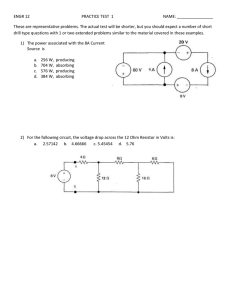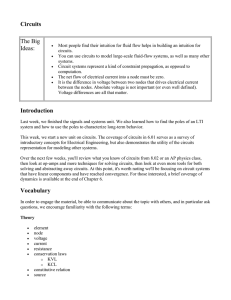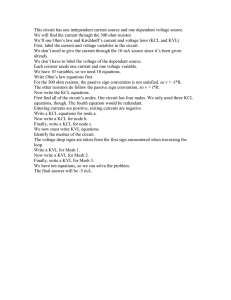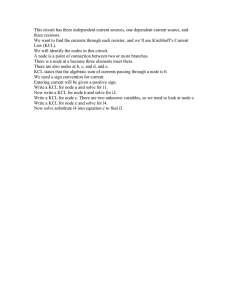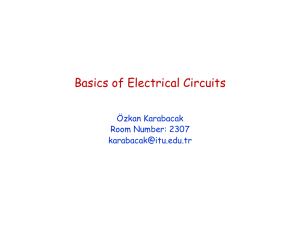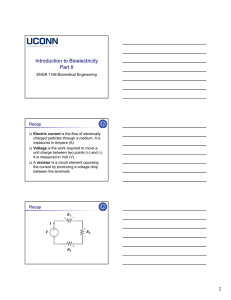ENGG1015 Tutorial Analyzing Circuits Warm Up Exercise / IQ Test
advertisement
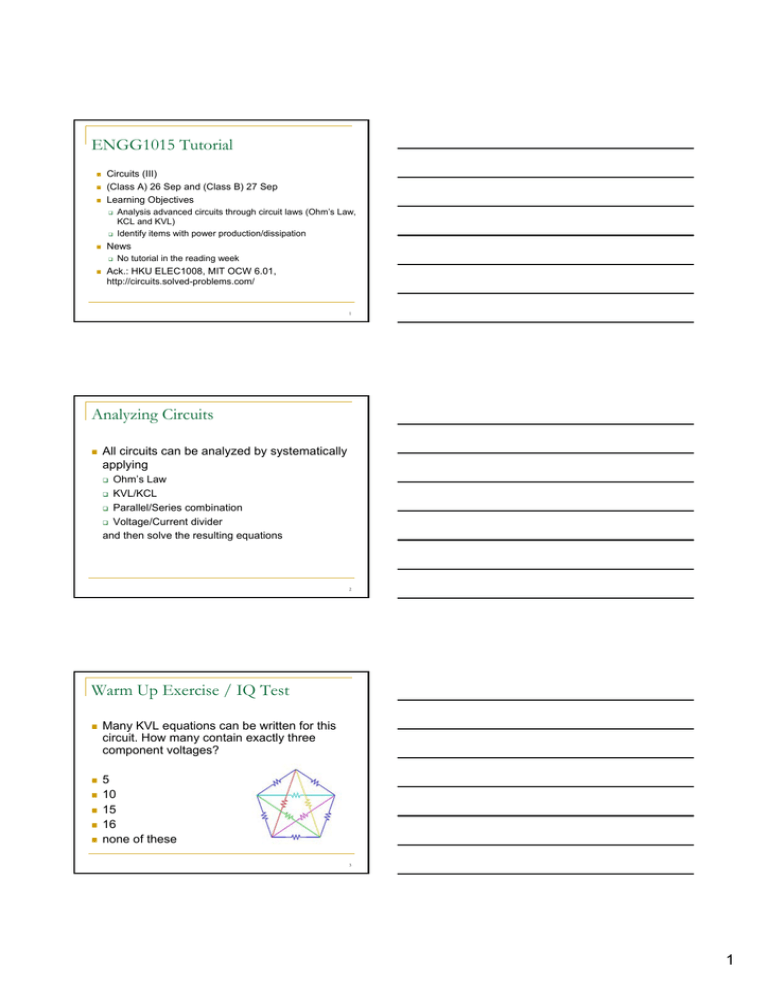
ENGG1015 Tutorial Circuits (III) (Class A) 26 Sep and (Class B) 27 Sep Learning Objectives Analysis advanced circuits through circuit laws (Ohm’s Law, KCL and KVL) Identify items with power production/dissipation News Ack.: HKU ELEC1008, MIT OCW 6.01, http://circuits.solved-problems.com/ No tutorial in the reading week 1 Analyzing Circuits All circuits can be analyzed by systematically applying Ohm’s Law KVL/KCL Parallel/Series combination Voltage/Current divider and then solve the resulting equations 2 Warm Up Exercise / IQ Test Many KVL equations can be written for this circuit. How many contain exactly three component voltages? 5 10 15 16 none of these 3 1 Analyzing Complicated Circuits Using node voltages is much easier than formulating KVL equations for complicated circuits Actually, we may analysis this circuit in practice 4 Analyzing Circuits Assign node voltage variables to every node except ground (whose voltage is arbitrarily taken as zero) Assign component current variables to every component in the circuit Write one constructive relation for each component in terms of the component current variable and the component voltage, which is the difference between the node voltage as its terminals Express KCL at each node except ground in terms of the component currents Solve the resulting equations 5 Question 1: Circuit Analysis R1 = 80Ω, R2 = 10Ω, R3 = 20Ω, R4 = 90Ω, R5 = 100Ω V1 = 12V, V2 = 24V, V3 = 36V I1 - I5 = ?, P1 - P5 = ? 6 2 Solution 1a VN = 0 M Æ R5 Æ V1 Æ R1 Æ B I2: M Æ V3 Æ R3 Æ R2 Æ B I4: M Æ V2 Æ R4 Æ B I1: Step 1, Step 2 7 Solution 1a VM – VB = R5I1 + V1 + R1I1 I1 = (VM – VB – V1)/(R5 + R1) = (24 – VB)/180 Step 3 8 Solution 1a VN – VB = R2I2 + R3I2 (VN – VB)/(R2 + R3) = – VB/30 I2 = Step 3 9 3 Solution 1a VM – VB = V2 + R4I4 (VM – VB – V2)/R4 = (12 – VB)/90 We get three relationships now (I1, I2, I4) I4 = Step 3 10 Solution 1a KCL of Node B: I1 + I4 + I2 = 0 (24 – VB)/180 + (12 – VB)/90 – VB/30 = 0 Step 4, Step 5 Æ VB = 16/3 V 11 Solution 1a I1 = (24 – VB)/180 = 14/135 A = 0.104A (12 – VB)/90 = 2/27 A = 0.074A I2 = – VB/30 = – 8/45 A = – 0.178A Step 5 P = I2R = … I4 = 12 4 Solution 1b Let’s try another approach VM = 0 (Different reference ground) B Æ R1 Æ V1 Æ R5 Æ M I2: B Æ R2 Æ R3 Æ V3 Æ M I4: B Æ R4 Æ V2 Æ M I1: 13 Quick Checking What are the current directions? VM = 0 (Different reference ground) I1: B Æ R1 Æ V1 Æ R5 Æ M I2: B Æ R2 Æ R3 Æ V3 Æ M I4: B Æ R4 Æ V2 Æ M 14 Quick Checking I1: B Æ R1 Æ V1 Æ R5 Æ M B Æ R2 Æ R3 Æ V3 Æ M I4: B Æ R4 Æ V2 Æ M Different direction, different result? I2: 15 5 Solution 1b KCL of Node B: I1 + I2 + I4 = 0 VB – VM = R1I1 – V1 + R5I1 I1 = (VB – VM + V1)/(R1 + R5) = (VB + 12)/180 16 Solution 1b VB – VM = R2I2 + R3I2 – V3 I2 = (VB – VM + V3)/(R2 + R3) = (VB + 36)/30 17 Solution 1b VB – VM = R4I4 – V2 (VB – VM + V2)/R4 = (VB + 24)/90 I4 = 18 6 Solution 1b KCL of Node B: I1 + I2 + I4 = 0 (VB + 12)/180 + (VB + 36)/30 + (VB + 24)/90 = 0 Æ VB = – 92/3 V 19 Solution 1b I1 = (VB + 12)/180 = –14/135 A = – 0.104A I2 = (VB + 36)/30 = 8/45 A = 0.178A I4 = (VB + 24)/90 = –2/27 A = – 0.074A P = I2R 20 Question 2: Circuit Analysis (II) Find vo in the circuit of the figure. 21 7 Solution 2 Step 1: Define the node voltage (v1,v2,v3) Step 2: Define the current direction 5A v2 v1 2Ω 1Ω 4Ω v3 8Ω + v0 -- 40V 20V 22 Solution 2 Apply: 1) V = IR 2) KCL Step 3: Consider node 1 v1 − v2 40 − v1 +5 = ⇒ 3v1 − v2 = 70 2 1 (1) 23 Solution 2 Step 3: Consider node 2 v1 − v2 v v −v + 5 = 2 + 2 3 ⇒ 4v1 − 7v2 = −20 2 4 8 ( 2) Step 4, 5: From (1) and (2), v1 = 30V, v2 = 20V, v0 = v2 = 20V 24 8 Power Dissipated in Resistors Power Dissipation: P = VI When Ohm’s Law Hold: P = VI = RI2 Units [Energy], J, kWh = 103 x 3600J [Power] = [Energy]/[time], W = J/s Power is important: It’s what does work in a circuit How much light is produced How much heat is produced 25 Question 3: Relationship between Power, Current, Voltage Find the power of each element. Which one is supplying power and which one is absorbing it? 26 Solution 3 A. B. C. D. Supplying power Absorbing power Absorbing power Supplying power P = V × I = −2 × 4 = −8W < 0 P = V × I = 4 × 2 = 8W > 0 P = V × I = 10 × 2 = 20W > 0 P = − (V × I ) = − (10 × 5 ) = −50W < 0 27 9

